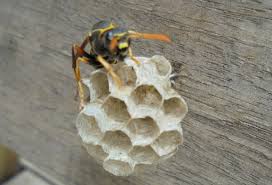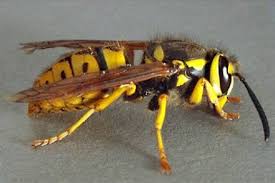5 ways to protect yourself from being stung by a bee or wasp
Bees and Wasps are extremely active this time of year while they get ready for the winter.
Getting stung by a bee is painful and can be a life or death situation for those who are allergic.
There are a few things you can do to keep yourself protected from bees and wasps according to About Education.
1. Don’t wear perfumes or colognes.
Don’t smell like a flower. Bees and wasps that are searching for nectar can detect and follow strong scents even from a distance. When they get a whiff of you, they could land on you to do some investigating.
2. Avoid wearing brightly colored clothing, especially floral prints.
This seems like a no-brainer. Don’t look like a flower. They love flowers. Bright colors attract bees, neutral colors do not.
3. Be careful what you eat outdoors.
Imaging Mike and I know this first hand. Bees and Wasps love beer. Look at Mike running like a crazy person from the bees in our golf cart! Sugary foods will attract bees and wasps, so keep them at a minimum and always check before you take a sip to see if one has flown in your drink.
4. Don’t walk barefoot.
Some wasps make their nests on the ground. If you step on or near one, it will try to protect itself and sting you. Word to the wise, always check before you sit down as well. I’ve sat on a bee before… it was very unpleasant.
5. Try not to wear loose-fitting clothes.
This goes for all insects I think. Just the other day I had a pair of loose-fitting pants on. When I sat down inside I felt like something was tickling my leg. It was a huge black ant. Scared me half to death! Be careful, if a bee or wasp gets caught in your baggy clothing, it could sting you while trying to get out.

Do bees get along with wasps and hornets?
Wasps will bully bees at feeding sites, shoving and pushing them around until they fly away . Ordinary common or German wasps (yellowjackets) will sneak into bee hives and try and rob the honey. They well also kill and eat honey bees if they get the chance.
Hornets will attack honeybees and kill them by biting their heads off. They then dismember the dead body and chew up the protein-rich flight muscles and fly back to their nest and feed them to the hornet grubs which then feed some of the nutrients back to the worker hornets in liquid form.
Some species of hornet like the Asian Vespa velutina, which is invasive in Europe, will hover outside beehives swooping down and picking off individual bees one by one. A single velutina hornet can kill 50 honey bees a day this way, so it is said
Larger hornets like the Asian giant hornet Vespa mandarinia will scout out a hive full of bees and then return to their own nest and use pheromones to gather a crew of 30 or so worker hornets who then attack the hive mob handed killing all the bees inside. They then take over the beehive raiding it until every bee grub has been eaten.

BEST WAYS TO KEEP BEES AWAY FROM YOUR SUMMER PICNIC
The summer picnic most often comprises a lovely day spent lounging on the grass, soaking up the sun, and enjoying a well-packed meal and the company of your friends and family (and those six-legged flying moochers ready to prey on your feast!). This time of year, bees are busy seeking out sweet smells and potent flowers. All too often they find their way not to a delectable blossom, but to your al fresco fruit salad. Here are a few suggestions to safely keep the Apidae out of your summer salad.
1. Play keep-away. Unlike mosquitoes, bees are not attracted to the smell of humans but rather to the sweet scents of their perfume, hair products, lotion, and deodorant.
- Avoid bee attention by wearing unscented products.
- Use an insect repellent to mask the scents. Natural repellents use citrus, mint, and eucalyptus oils.
- Dryer sheets also make effective insect repellents: tuck one in your pocket if you’re hiking or place a few under your picnic blanket.
2. Practice the art of disguise. You can mask not only the scent of your perfumes, but also that of your food with a little clever camouflage.
- Scatter cloves or mint across your table or blanket.
- Another idea is to set a pot or two of marigolds on the table. They look like pretty centerpieces, but their scent repels bees as well.
3. Cover up. Use lids for your food containers and your beverages. Keep trash bags or cans tightly closed as well. This will help reduce the wafting aromas that might entice these pesky insects. The scent of barbecue not only brings people to your party, it is especially compelling for bees and wasps as well, so keep that under wraps as much as possible.
4. Bait and switch. Set out a bowl or cup with some flat soda, fruit juice, maple syrup, or sugar water a few yards away from your picnic. Bees are attracted to the sugary scent and will pursue this instead of your lunch. If possible, set out the bee bait 20 minutes or so before you begin your picnic because the bees will communicate the location of the sugary food to one another. If you are using a soda bottle, remove the label so that no one but the bees tries to drink from it.

Aggressive Hornets
Hornets are one of the most aggressive types of wasp, and many are able to sting through clothing and protective gear. Like yellow jackets, hornets are very protective of their nests, which can usually be found in the ground, hollows of trees, tree branches and near roof gutters, among other protected places. Certain types of hornets, such as the bald-faced hornet, will protect its nest by employing two of its team to circle near the nest surveying the area for threats. Once these “watchmen” feel their nest is in danger, they alert their team inside, and all attack as a united group.
Wasps Are More Dangerous than Bees
While many people would consider wasps the more aggressive of the two, this is actually false. Wasps and bees have different temperaments, and their level of aggression is often dependent on how you encounter them. Wasps tend to conceal their nests in spaces that aren’t visible to the naked eye, resulting in unexpected encounters, whereas bees nests tend to be harder to find. However, when one does encounter a nest, they tend to swarm in significantly larger numbers than wasps to defend their nest, making them equally as dangerous.
Wasps Don’t Produce Honey (and all bees do)
While this one may be true in your particular area of the world, it is actually false. There are some species of wasp, particularly the Mexican Honey Wasp, that do produce honey. In fact, according to Reader’s Digest, less than 5% of all bee species make honey.
It’s Safe to Remove a Wasp (or bee) Nest at Night
While this rumor is founded in truth, it is in fact false. The truth is that it is significantly safer to remove a nest at night than during the day, as this is when bees and wasps are less active, but that does not mean its fool proof. Wasps or bees that are disturbed at night still carry the potential to sting you.